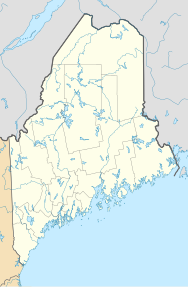Dayton, Maine
| Dayton, Maine | |
|---|---|
| Town | |

Union Falls Bridge, c. 1908
|
|
| Coordinates: 43°32′34″N 70°34′46″W / 43.54278°N 70.57944°WCoordinates: 43°32′34″N 70°34′46″W / 43.54278°N 70.57944°W | |
| Country | United States |
| State | Maine |
| County | York |
| Incorporated | 1854 |
| Government | |
| • Type | Board of Selectmen |
| • Selectman, Chair | Theodore Poirier |
| • Selectmen | Scott Littlefield Gerry Taylor |
| Area | |
| • Total | 18.40 sq mi (47.66 km2) |
| • Land | 17.89 sq mi (46.33 km2) |
| • Water | 0.51 sq mi (1.32 km2) |
| Elevation | 220 ft (67 m) |
| Population (2010) | |
| • Total | 1,965 |
| • Estimate (2012) | 2,006 |
| • Density | 109.8/sq mi (42.4/km2) |
| Time zone | Eastern (EST) (UTC-5) |
| • Summer (DST) | EDT (UTC-4) |
| ZIP code | 04005 |
| Area code(s) | 207 |
| FIPS code | 23-16725 |
| GNIS feature ID | 0582434 |
| Website | http://www.dayton-me.gov/ |
Dayton is a town in York County, Maine, United States. The population was 1,965 at the 2010 census. It is part of the Portland–South Portland–Biddeford, Maine metropolitan statistical area. Dayton is one of the smallest towns in York County.
The area was once inhabited by the Sokokis (or Saco) Indians, who hunted and fished along the Saco River. The old Sokokis Trail is now Route 5, which passes through Dayton. In 1664, Major William Phillips purchased from the sagamore the land which would become Little Falls Plantation—today the towns of Hollis, Dayton and part of Limington. In 1728, a fort which contained a trading post was built a half mile below Union Falls. Called the Saco Truck House or Saco Block House, the garrison was maintained throughout the French and Indian War until the fall of Quebec in 1759.
Settlers arrived in 1753, and lumbering became a principal industry. Logs were rolled down the banks of the Saco River and floated to sawmills at Saco. Nathaniel Goodwin established the first local mill in 1782 at Goodwins Mills, where falls in Swan Brook drop 33 feet (10 m). A sawmill and gristmill were erected at Union Falls (then called Hopkinson's Mill) in 1806. Tanneries were built, and land was cleared for farms. In 1798, Little Falls Plantation was incorporated as Phillipsburg, in honor of Major William Phillips—but only until 1810. Considered difficult to pronounce and write, the Phillipsburg was changed to Hollis. Then, in 1854, the southern part of Hollis petitioned the state legislature to become a separate town. Permission was granted, and the community was named Dayton after Thomas Day, who submitted the petition.
...
Wikipedia

